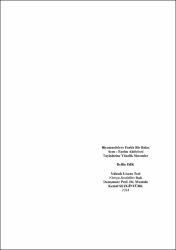| dc.contributor.author | Işık, Berfin | |
| dc.date.accessioned | 2017-05-16T07:15:20Z | |
| dc.date.available | 2017-05-16T07:15:20Z | |
| dc.date.issued | 2014 | |
| dc.identifier.uri | https://hdl.handle.net/20.500.11776/1052 | |
| dc.description.abstract | Tripsin çoğu omurgalının sindirim sisteminde bulunan proteinleri parçalayıcı özelliğe sahip bir sindirim enzimidir. Pankreastan in aktif bir proenzim olan tripsinojen şeklinde üretilir ve ince bağırsağa ulaştığında enteropeptidaz tarafından aktif hale getirilir. Bu yüksek lisans çalışmasında tripsin aktivite tayini için amperometrik biyosensör geliştirildi. Geliştirilen biyosensörün çalışma prensibi, tripsinin GOD biyoaktif tabakasını hidrolizleyerek sinyal düşüşünün izlenmesine dayanmaktadır. GOD ve jelatin, camsı karbon elektrot yüzeyine tutturularak ve glutaraldehit ile çapraz bağlama yapılarak immobilize edildi. Oluşturulan biyosensörün optimizasyonu amacıyla jelatin miktarı, enzim inkübasyon süresi, optimum sıcaklık, GOD derişimi, çalışma potansiyeli ve NaHCO3 tamponu pH ‘ı gibi parametreler için deneysel çalışmalar yapıldı. Biyosensörün karakterizasyon çalışmalarında ise tekrarlanabilirlik, tekrar üretilebilirlik, kalibrasyon grafikleri, amperometrik ve EIS yöntemleri kullanılarak gerçek örnek ile de çalışıldı. | en_US |
| dc.description.abstract | Trypsin is a digestive enzyme most of found in digestive system of vertebrates. Pancreatic trypsinogen, which is produced as an inactive proenzyme and reaches the small intestine can be activated by enteropeptidase. In this thesis an amperometric biosensor was developed for the determation of tyripsin activity. Principle of this new biosensor system is based on the hydrolysis of GOD’s bioactive layer by trypsin and consequently decrease in the amperometric signal. Glucose oxidase and gelatin mixture was layered onto the surface of the glassy carbon electrodes. Glucose oxidase was crosslinked by glutaraldehyde that was used as a crosslinking agent. On the purpose of optimize biosensor, some parameters such as optimum temperature, concentration of gelatin, incubation time of elastase, concentration of glucose oxidase, optimum working potential, and pH for NaHCO3 buffer have been studied. Immobilization steps were monitored by EIS and chronoamperometry. Repeatability, reproducility and related statistical parameters were also investigated. Finally the biosensor presented in this thesis was applied to the real serum samples. | en_US |
| dc.language.iso | tur | en_US |
| dc.publisher | Namık Kemal Üniversitesi | en_US |
| dc.rights | info:eu-repo/semantics/embargoedAccess | en_US |
| dc.subject | Enzim aktivitesi | en_US |
| dc.subject | tripsin | en_US |
| dc.subject | GCE | en_US |
| dc.subject | biyosensör | en_US |
| dc.subject | Enzyme activity | en_US |
| dc.subject | trypsin | en_US |
| dc.subject | biosensor | en_US |
| dc.title | BİYOSENSÖRLERE FARKLI BİR BAKIŞ AÇISI : ENZİM AKTİVİTESİ TAYİNLERİNE YÖNELİK SİSTEMLER | en_US |
| dc.title.alternative | A DIFFERENT PERSPECTIVE OF BIOSENSORS: SYSTEMS FOR DETERMINATION OF ENZYME ACTVITY | en_US |
| dc.type | masterThesis | en_US |
| dc.department | Enstitüler, Fen Bilimleri Enstitüsü, Kimya Ana Bilim Dalı | en_US |
| dc.relation.publicationcategory | Tez | en_US |



















